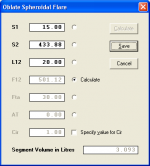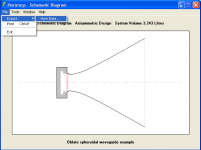But Manger has pistonic directivity, thus it is ringradiator. BMR46 from the other side very stiff and has flat power response. It is sensitive to baffle irregularities (3kHz on the graph).
Wow! Thats the kind of polar response the manufacturer would hope you never see!
Isn't it an opposite direction - fully uncontrolled directivity but total radiated power constant? That's he beauty of DML/BMR.
No, if those are polar curves its just bad. I don't see "constant power" only completely "uncontrolled directivity". Thats the problem with DML/BMR! There is nothing "beautiful" about that response.
No, if those are polar curves its just bad. I don't see "constant power" only completely "uncontrolled directivity". Thats the problem with DML/BMR! There is nothing "beautiful" about that response.
Absolutely agreed.
Quite interestingly, I ran across a coniguration that gave pretty good directivity probably slightly better than the last posted configuration I made, but with only a 3db slope.
Interested if you possibly like to share some plots of these ?
Michael
I can provide an excel worksheet (size~35k) which allows the display of any variety of profiles based on the oblate spheroid formula. JoshK did most of the work to get it to the current state. That includes a roundover transition to the baffle. I'd be glad to e-mail it by request and/or send it to someone who could provide a "host" site for it.
A question for Earl: In this worksheet the roundover is a circular arc that is tangent with the WG and the baffle. Is there a better shape (maybe a segment of a spiral) for the transition from the waveguide to the baffle?
Im looking for the OS waveguide formula/spreadsheet so I can start to get one built.
Does it exist anywhere?
I modified my simple oblate spheroid spreadsheed so you can set the initial throat angle using the Goal Seek function in Excel. No effort was made to make it "pretty" but it works.
http://www.crestviewcable.com/~catapult/Geddes.xls
I guess this is it.
Does that spreadsheet represent Geddes waveguides?
Last edited:
I guess this is it.
Does that spreadsheet represent Geddes waveguides?
I cannot confirm that one way or the other.
The OS wave guide throat properties can be calculated directly in the sheet I developed:
Just enter the throat radius, throat angle and exit angle. The spread sheet lists the X value where Y = throat radius with the specified angle along with a list of X,y coordinates.
The sheet can be downloaded here.
An externally hosted image should be here but it was not working when we last tested it.
Just enter the throat radius, throat angle and exit angle. The spread sheet lists the X value where Y = throat radius with the specified angle along with a list of X,y coordinates.
The sheet can be downloaded here.
Im looking for the OS waveguide formula/spreadsheet so I can start to get one built. Does it exist anywhere?
Hi doug20,
If you are familiar with Hornresp, simply use the Horn Segment Wizard tool to design any OS waveguide you wish, and then export the Schematic Diagram horn data. Note that the throat entry half-angle AT does not necessarily have to be 0 degrees.
Kind regards,
David
Attachments
There are techniques that can extract TS parameters without touching the device at all.
Telepathy, perhaps?
Does that spreadsheet represent Geddes waveguides?
the spreadsheet saysI cannot confirm that one way or the other.
are you avoiding answering the question for commercial reasons?Oblate Spheroid formula courtesy Earl Geddes
Equally we can all see that your implementation uses a radius at the mouth that the spreadsheet omits.
You could easily and truthfully confirm that the Gedlee waveguide is not the same.
More helpfully you could tell us that part is true and part is untrue and go on to show us how to do it properly.
mechanical computers
Anybody tried stretched string method to make these shapes
hyperboloid
regards Max Albin.
Anybody tried stretched string method to make these shapes
hyperboloid
regards Max Albin.
I totally agree...however, it might promote an unwanted result: That someone else would recognize an area for improvement and get there first.More helpfully you could tell us that part is true and part is untrue and go on to show us how to do it properly.

doug20, ygpm
Last edited:
I don't think I kept them because the usable bandwidth was 2K~10KHz, not what I wanted.Interested if you possibly like to share some plots of these ?
Michael
Telepathy, perhaps?
I'm not sure if this is sarcasm or what, but the technique is available to read about in a US patent that was issued on it. It would even work for compression drivers if measured on a plane wave tube.
I would think it would be a different set of tradeoffs. Bear in mind that we are dealling with a wide band width. The OSWG performs well at the highest frequency the throat is designed for. The foam is a very important part of the design. Without it, the performance is not so good. But more important seems to be the match between the driver and the horn/guide.I totally agree...however, it might promote an unwanted result: That someone else would recognize an area for improvement and get there first.
doug20, ygpm
the spreadsheet says are you avoiding answering the question for commercial reasons?
Equally we can all see that your implementation uses a radius at the mouth that the spreadsheet omits.
You could easily and truthfully confirm that the Gedlee waveguide is not the same.
More helpfully you could tell us that part is true and part is untrue and go on to show us how to do it properly.
What I meant was that I cannot confirm the implimentation because I did not write it. The critrical part is the initial angle and John seems to get that right. The equations that he is using are correct.
Use JohnK's, catapult's or my spreadsheet, or presumably McBean's HornResp, and you get the OS profile. I understand if Dr. Geddes doesn't want to confirm our results, but the equation is readily available, it comes from math/physics, specifically OS coordinate transformation to solve a class of (partial) differential equations.
I have not verified JohnK's or Dennis's results (catapult). However, both these guys have very strong math backgrounds and the equation is straightforward, so I have zero doubt they did it right. Someone mentioned some while ago that the results were confirmed from one to the other.
The only non-trivial part is solving for a non-zero initial exit angle. I solved it analytically, as I found it a fun excercise to dust off some math skills. I think Dennis solved it numerically. Either way works.
I have not verified JohnK's or Dennis's results (catapult). However, both these guys have very strong math backgrounds and the equation is straightforward, so I have zero doubt they did it right. Someone mentioned some while ago that the results were confirmed from one to the other.
The only non-trivial part is solving for a non-zero initial exit angle. I solved it analytically, as I found it a fun excercise to dust off some math skills. I think Dennis solved it numerically. Either way works.
I don't think I kept them because the usable bandwidth was 2K~10KHz, not what I wanted.
What a pity !
I would have loved to have a look at the transition between the usual 6dB CD roll off and my close to flat FR CD.
Michael
- Home
- Loudspeakers
- Multi-Way
- Geddes on Waveguides

